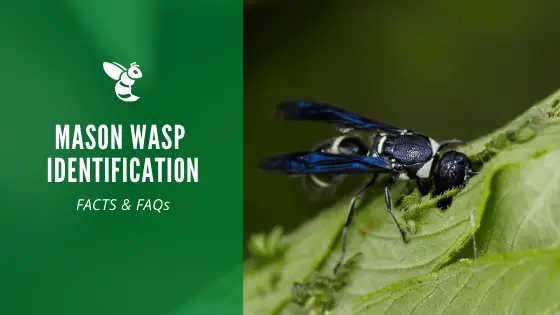Mason Wasp (Potter Wasp) Identification: Nests, Stings, & Removal Tips

Wasps serve a pretty beneficial purpose. They help to control other pests on your property and in the area. They also pollinate local plants. The mason wasp looks a little threatening with the way its body is structured, but it still has its place in our ecosystem.
Have you noticed a large wasp (or two) in your yard with a very thin body and spots on its face? You might have a mason wasp colony nearby.
The mason wasp will be anywhere from ½ inch to ¾ inch when they are adults. The females tend to be a little bit bigger. There are a few different kinds of mason wasps, with the four-toothed mason wasp having a black body with a white band across its mid-section. There is also a red and black mason wasp with yellow spots on its face for the males.
Do Mason Wasps Nest in Walls?
Walls are a very common location for the mason wasp. They find different cracks and holes in the wood of your home, shed, porch, patio, etc. They can even dig into the mortar that’s in between the brick on your house and nest there.
Their main goal is to nest somewhere that’s easy to get in and out of, but they also want to make sure that they are protected from the different weather patterns that may come through the area during the spring and summer months.
Mason wasps feed off the nectar of plants, and they also consume bugs like caterpillars and corn earworms. If you have a population of these insects nearby, this is likely where your mason wasp is living as well. They will kill many of them all at once, stuffing them into their nest to keep as future meals. They will also feed these insects to their young to help them grow.
Mason Wasps Nests
The mason wasp is completely solitary, so it doesn’t create a colony in a large nest. Their nest has to be big enough for them to fit inside. They’ve been known to repurpose a nest from another solitary wasp like the mud dauber. If they’re hard-pressed to find somewhere to make their home, they may settle for a hole in the ground.
Do Mason Wasps Sting?
Mason wasps do have the ability to sting. It’s important to keep in mind that they’re solitary. While you may get stung by the mason wasp, there isn’t going to be a big swarm of them that come after you. Of course, make sure you’re protected if you’re removing their nest to prevent any stings from occurring. You should be extra careful if you’re prone to an allergic reaction from the sting.
Are Mason Wasps Aggressive?
Mason wasps are pretty harmless and non-aggressive. If they’re disturbed, or they spot you near their nest, they may sting you. If you’re keeping to yourself and staying out of their way, they’re going to leave you alone as well.
You can pretty easily co-exist with a mason wasp unless their nest is somewhere very close to where you spend time outside of it’s near a door or window where they could get inside. Chances are they’re going to be gone once winter rolls around, and you’ll never see them again.
Mason Wasp Removal
If you decide that it’s necessary to remove the mason wasp that is living on your property it’s important to determine where their nest is located.
You may have discovered you have a mason wasp by viewing them fly in or out of their nest hole. This provides you with a simple process of removal. If you know that the wasp is away from the nest (which is likely during the daytime), you can remove their nesting material and fill the hole.
Just keep a close eye out for the wasp coming back to the nest with food. They’re not going to be happy that you’re there.
Mason wasps will come back to their home at the end of the day when temperatures outside begins to lower, and the sun is going down. Wasps tend to rest during the nighttime hours, and the same is true for the mason wasp. You have the option to spray their nest with them in it if you have a pesticide spray that is effective against wasps.
It’s most effective to spray the hole when you have seen the wasp return. This way, you’ll kill them on contact and not be relying on them to come in contact with the product when they return.
Conclusion
If you’re trying to determine what kind of wasps you have on your property, you mustn’t confuse the mason wasp with the mason bee. The names are very similar, but there are some distinct differences in their size (mason wasps tend to be larger).
Mason bees have a larger palette of colors that can include metallic green and blue shades. While you may be able to eradicate them the same way, it’s always helpful to know exactly what you’re dealing with. This helps you determine where their nest may be, how many of them there may be, etc.



